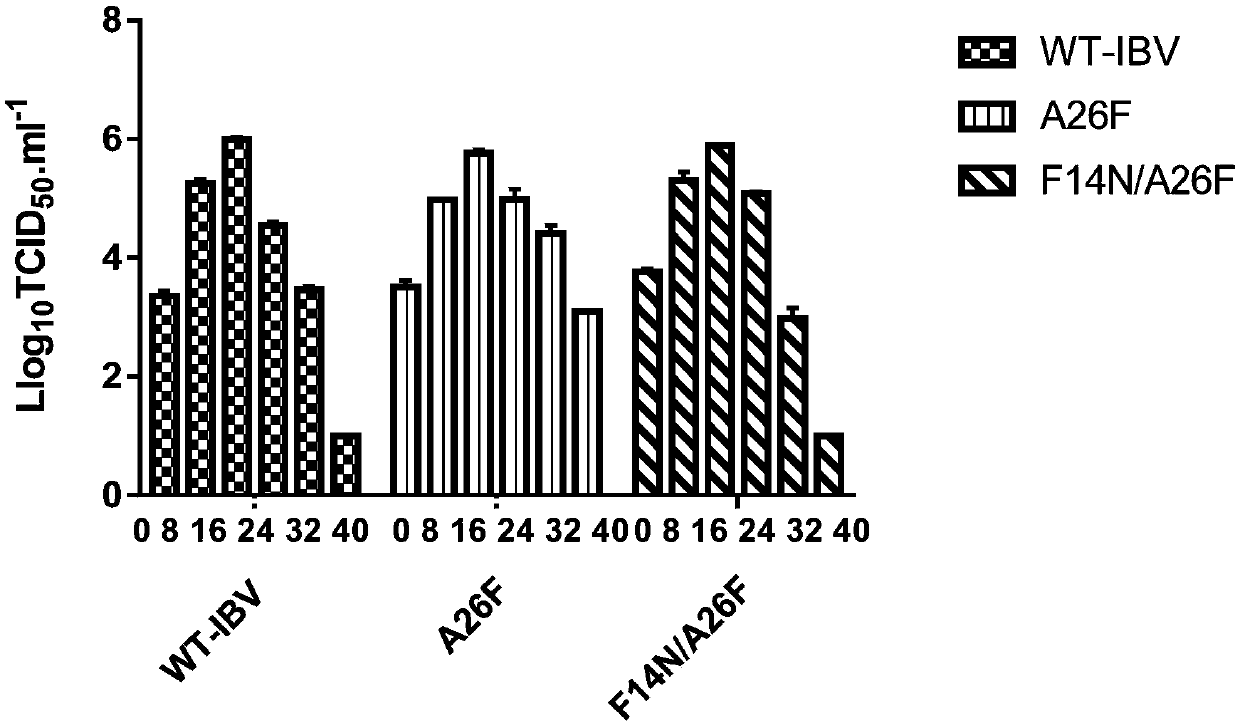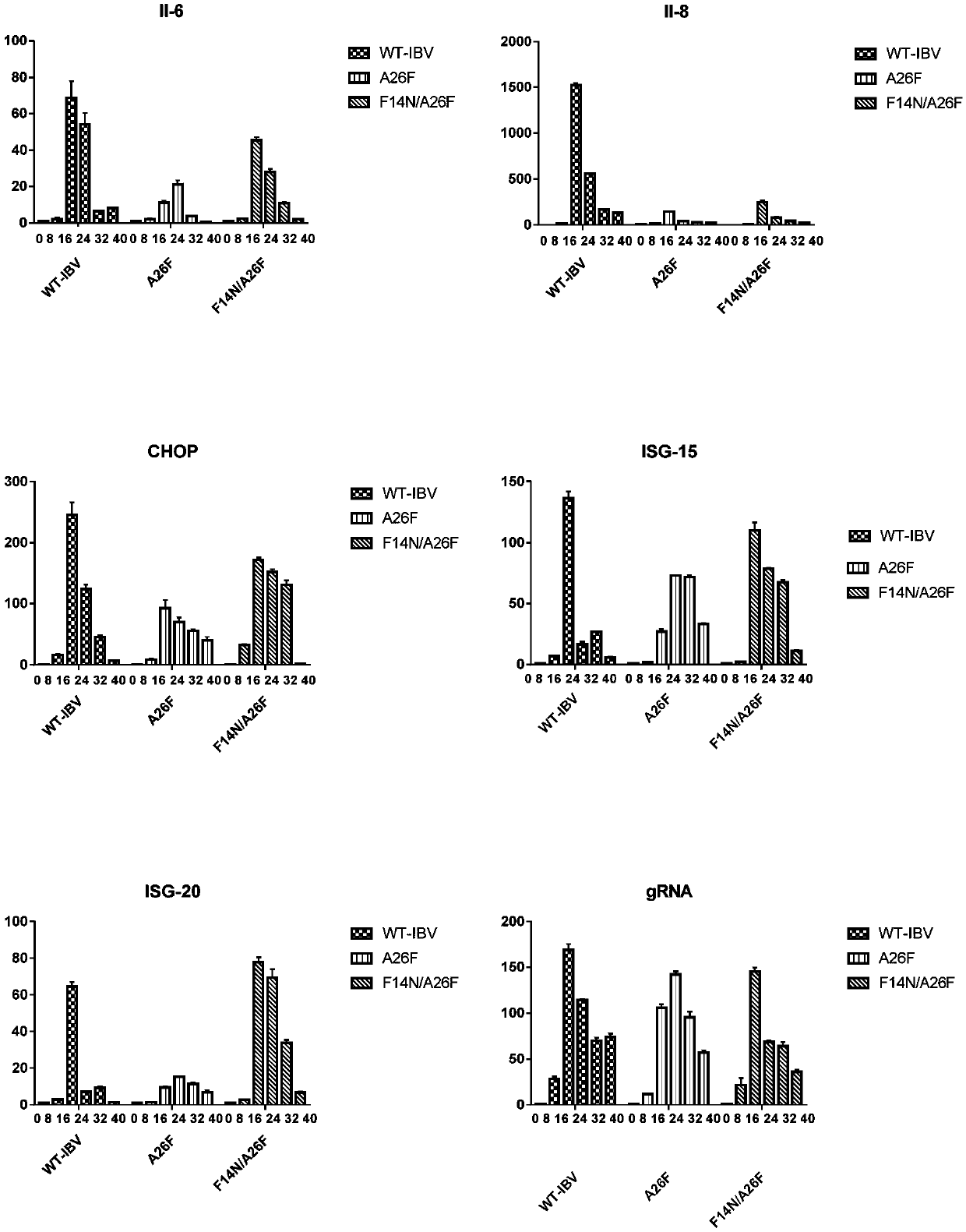Infectious bronchitis recombinant virus lack of E protein ion channel activity as well as preparation method and application
A bronchitis, ion channel technology, applied in the field of molecular biology, can solve problems such as titer decrease, apoptosis increase, virion morphology defects, etc.
- Summary
- Abstract
- Description
- Claims
- Application Information
AI Technical Summary
Problems solved by technology
Method used
Image
Examples
Embodiment 1
[0096] Example 1 IBV infectious cDNA cloning based on seamless cloning technology
[0097] Based on seamless technology, the mutation design of the E protein gene locus sequence of infectious bronchitis virus was carried out, and 5 fragments across the entire IBV genome were obtained, namely fragment A, fragment B, fragment C, fragment D and fragment E. Restriction sites were introduced into the 5'end and 3'end of the 5 fragments, combined with the T7 promoter, and ligated in vitro to obtain a cloned strain, and transcribed in vitro to obtain a full-length RNA (such as figure 1 Shown); The specific steps are as follows:
[0098] (1) Use chicken IBV to infect African green monkey kidney cells (Vero cells, ATCC). For the source and infection method of IBV, please refer to the literature "S. Shen, et al. Emergence of a coronavirus infectious bronchitis virus mutant with a truncated 3b gene: functional characterization of the 3b protein inpathogenesis and replication.".
[0099] (2) The...
Embodiment 2
[0114] Example 2 The recombination and purification method of rIBV-A26F lacking the activity of the E protein ion channel includes the following steps:
[0115] (1) First, use seamless cloning technology to design the deletion of the E protein gene site sequence of infectious bronchitis virus, combine with the T7 promoter, and connect in vitro to obtain a complete RNA clone; then the above clone is cloned for infectious, The cloned sequence to be obtained is introduced into Vero cells by electrotransformation method to obtain recombinant infectious bronchitis virus lacking the activity of the E protein ion channel: the specific operation is the same
[0116] Example 1.
[0117] (2) Collect the cell supernatant infected with rIBV-A26F, and then dilute it 10 times with serum-free DMEM, and test the virus titer by plaque purification experiment.
[0118] (3) Infect the diluted supernatant virus into a plate paved with Vero cells in a 6-well plate. After 2 hours, the virus is adsorbed, th...
Embodiment 3
[0124] Example 3 Stability analysis of attenuated strains of IBV mutants adapted to the lack of E protein ion channel activity of Vero cells
[0125] (1) Infect Vero cells with rIBV-A26F mutant virus, culture at 37°C for 24 hours, collect the supernatant, and then use the supernatant virus to infect newly plated Vero cells, and so on to infect 30 generations;
[0126] (2) Collect, lyse and extract the cellular RNA infected with the virus at generations 5, 10, 15, 20, 25, and 30, RT-PCR, E gene sequencing, and sequence comparison to see if there are any new mutations in the E gene. To determine the genetic stability of the strain, the primers of the amplified E gene are the same as those in Table 2, and the sequencing primers are the upstream primers.
[0127] (3) Analysis of sequencing results. Starting from the 10th generation, the second T of the 26th amino acid phenylalanine of the rIBV-A26F mutant virus was gradually replaced with C, and the original TTT codon was converted to TC...
PUM
 Login to View More
Login to View More Abstract
Description
Claims
Application Information
 Login to View More
Login to View More - R&D
- Intellectual Property
- Life Sciences
- Materials
- Tech Scout
- Unparalleled Data Quality
- Higher Quality Content
- 60% Fewer Hallucinations
Browse by: Latest US Patents, China's latest patents, Technical Efficacy Thesaurus, Application Domain, Technology Topic, Popular Technical Reports.
© 2025 PatSnap. All rights reserved.Legal|Privacy policy|Modern Slavery Act Transparency Statement|Sitemap|About US| Contact US: help@patsnap.com



